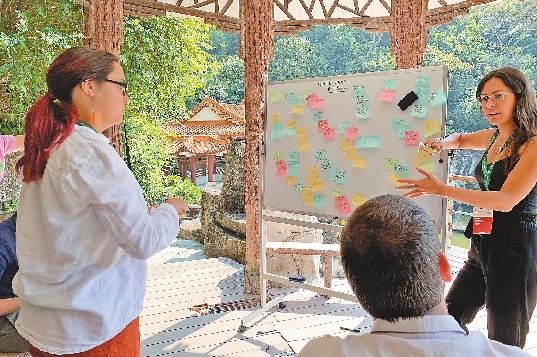
Chen Xiaochun 654789759@qq.com ENTERING Fairy Lake Botanical Garden on Saturday morning and you would have encountered some 100 talents scattered around the natural gem brainstorming on topics related to climate action. Among them, a group of four occupying a pavilion overlooking a pond were discussing their ideas about how to utilize local knowledge to help with flood prediction. The group consisted of Turkish-German Arzucan Askin, who is a geographer and an independent journalist focusing on political ecology issues, Robert Sakic Trogrlic, from Bosnia, who is finishing his Ph.D. in Malawi focusing on using local knowledge to predict flood risks, Venezuelan-British Sofia Taylor and Hassan De Leon (an alias) from the U.S. “Local communities that experience floods have knowledge of early warning indicators. In this case, we are primarily looking at natural indicators like animals or plants, and how we can tell from the way they change, what they do and how they behave if there is a flood coming,” Askin told the Shenzhen Daily. “In both flora and fauna, for instance, the local community will see hippos behaving in a certain way before floods might be coming, or they will see trees flowering in a certain way, which indicates that the season might be rainy and there might be floods,” Sakic Trogrlic said as he explained the idea of local early warning indicators for floods to Lee Chuan Guan, an adjunct professor at Renmin University of China and an expert at UNLEASH 2019. “For example, a friend of ours told us that his colleagues who work for the Red Cross said all local farmers knew when there was a flood coming because of what the plants did, but we as NGO workers couldn’t put this into practice because we didn’t know how to put this knowledge into our framework,” said Askin. Askin cited another example of fishermen in Cuba who know when a storm is coming and warn their families before the national government even gives a warning. “So, the problem is that there is all this knowledge, but it’s not integrated in the existing disaster prediction system.” Their idea is to collect and transfer this knowledge to other communities, NGOs and people that usually come to work in those areas. “NGOs, charities and volunteers are coming and helping, but they don’t have that knowledge or a way to use the knowledge,” said Taylor. “So what we want to bring together is this local knowledge, plus scientific data on animal behavior or plant behavior and the data on floods that has been collected by scientists, and then analyze it using artificial intelligence to prove there is a correlation, in the hope that disaster risk prediction strategies can incorporate more local knowledge because currently they are not incorporating local knowledge,” said Askin. After listening to the group’s idea, Lee suggested they pay attention to the connection between different natural disasters. “Floods and earthquakes are connected. For example, animals that burrow into the ground, they know when there is going to be an earthquake, and way before that they have already moved out because they have their ears on the ground.” “So when you are looking at flooding, don’t exclude things like earthquakes, because the data is connected. The value of your data increases because now it’s not just about flooding, it’s also about earthquakes. That’s one point I want to share with you,” added Lee. | 
